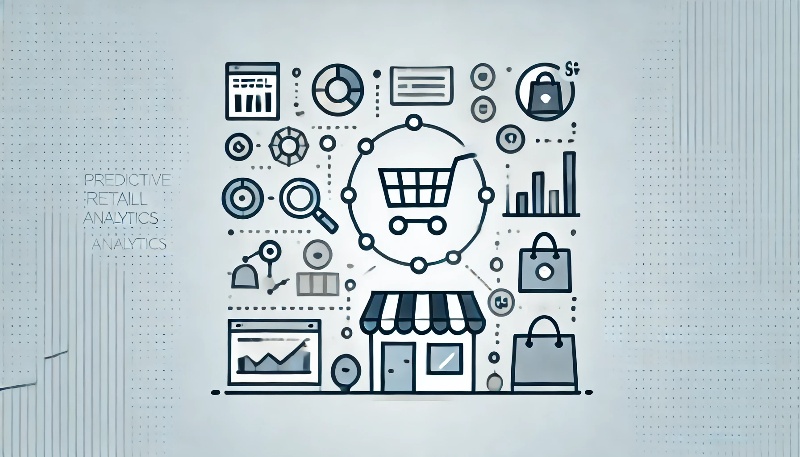Predictive Retail Analytics: Market Trends, Technologies, and Competition
In today’s fast-paced retail environment, staying ahead of consumer behavior and market trends is essential for survival. Predictive retail analytics uses advanced data analysis techniques, powered by artificial intelligence (AI) and machine learning (ML), to help retailers forecast demand, optimize inventory, personalize customer experiences, and increase profitability. This blog will explore the growing market for predictive retail analytics, the technologies driving innovation, the competitive landscape, and recent developments transforming the retail industry.
Market Overview
The global market for predictive retail analytics is experiencing significant growth, driven by the increasing adoption of big data technologies, AI, and machine learning across the retail sector. The market is expected to grow at a CAGR of 33.2% between 2024 and 2031, reaching a valuation of over $17 billion by the end of the decade.
As more retailers shift toward e-commerce and omnichannel strategies, they are turning to predictive analytics to gain insights into consumer behavior, optimize operations, and create personalized shopping experiences. By leveraging historical sales data, customer preferences, and market trends, predictive retail analytics helps retailers anticipate demand, reduce inventory costs, and improve marketing effectiveness.
Key Technologies Driving Predictive Retail Analytics
- Artificial Intelligence (AI) and Machine Learning (ML): AI and ML algorithms are at the heart of predictive retail analytics, allowing retailers to analyze vast amounts of data in real-time. These technologies can identify patterns in consumer behavior, predict product demand, and optimize pricing strategies. Machine learning models continuously improve over time, providing increasingly accurate forecasts and recommendations.
- Big Data Analytics: The explosion of digital data, from online shopping behaviors to social media interactions, provides a wealth of information for retailers. Predictive analytics tools process this data, extracting valuable insights that help retailers forecast demand, personalize marketing campaigns, and optimize stock levels. With big data, retailers can better understand customer preferences and shopping patterns.
- Customer Relationship Management (CRM) Integration: CRM systems are increasingly integrated with predictive analytics to enhance customer engagement. By analyzing data on customer interactions, purchases, and preferences, retailers can predict future buying behaviors, recommend products, and create personalized marketing campaigns that increase customer loyalty.
- Natural Language Processing (NLP): NLP allows predictive retail analytics tools to process unstructured data from various sources, including customer reviews, social media comments, and online inquiries. By analyzing this language-based data, retailers can gain insights into customer sentiment, identify emerging trends, and improve product offerings.
- Demand Forecasting Tools: Predictive analytics tools use historical sales data, external factors such as seasonality, and real-time data from stores to forecast demand accurately. Retailers can optimize inventory, ensuring they stock the right products in the right quantities, minimizing both overstocking and stockouts.
Competitive Landscape
The predictive retail analytics market is highly competitive, with established technology providers and specialized analytics firms vying for market share. Major players in this space include SAP SE, IBM Corporation, Microsoft Corporation, Salesforce, and Oracle Corporation. These companies are driving innovation with AI-powered analytics platforms designed to enhance retail operations.
- SAP SE offers its SAP Customer Activity Repository (CAR), a predictive analytics tool that helps retailers forecast demand and optimize inventory across channels. SAP integrates AI and machine learning to improve forecasting accuracy and provide real-time insights.
- IBM Corporation provides AI-driven retail analytics through its IBM Watson platform, enabling retailers to analyze customer data, predict demand, and personalize the shopping experience. Watson’s machine learning capabilities offer deep insights into consumer behavior, helping retailers drive more effective marketing strategies.
- Microsoft Corporation has developed Microsoft Dynamics 365 for Retail, a cloud-based analytics solution that offers predictive insights into customer preferences, inventory needs, and sales trends. Microsoft’s AI capabilities enhance demand forecasting and customer segmentation.
- Salesforce offers Salesforce Einstein, an AI-powered analytics platform that enables retailers to personalize customer experiences by analyzing historical data and predicting future buying patterns. Salesforce Einstein provides actionable insights for marketing, sales, and customer service.
- Oracle Corporation provides a suite of retail analytics tools, including Oracle Retail Insight Cloud Service, which leverages AI and machine learning to provide predictive insights into product demand, pricing, and promotions. Oracle focuses on helping retailers optimize their entire value chain, from supply chain management to customer engagement.
Recent Developments in Predictive Retail Analytics
- SAP recently enhanced its SAP Commerce Cloud, integrating more advanced AI and machine learning capabilities to offer better demand forecasting and personalized customer engagement solutions. This allows retailers to provide seamless shopping experiences across all touchpoints.
- Salesforce expanded its AI-powered Einstein for Retail platform, adding new features that improve inventory management and automate personalized product recommendations based on real-time customer behavior.
- Microsoft introduced a new set of AI-driven tools for its Dynamics 365 Commerce platform, designed to offer predictive insights into customer preferences, pricing strategies, and inventory management, helping retailers enhance the omnichannel experience.
- Oracle launched its Oracle Retail Data Platform, which uses machine learning to analyze customer data and predict trends in consumer buying behavior, helping retailers optimize product assortments and marketing campaigns.
Conclusion
Predictive retail analytics is revolutionizing the retail industry by providing actionable insights that enable better decision-making, from demand forecasting to personalized marketing. As technologies like AI, ML, and big data continue to evolve, retailers are gaining more precise tools to anticipate customer needs and optimize operations. With an increasingly competitive landscape and continuous technological advancements, predictive retail analytics will remain a critical tool in the future of retail.
